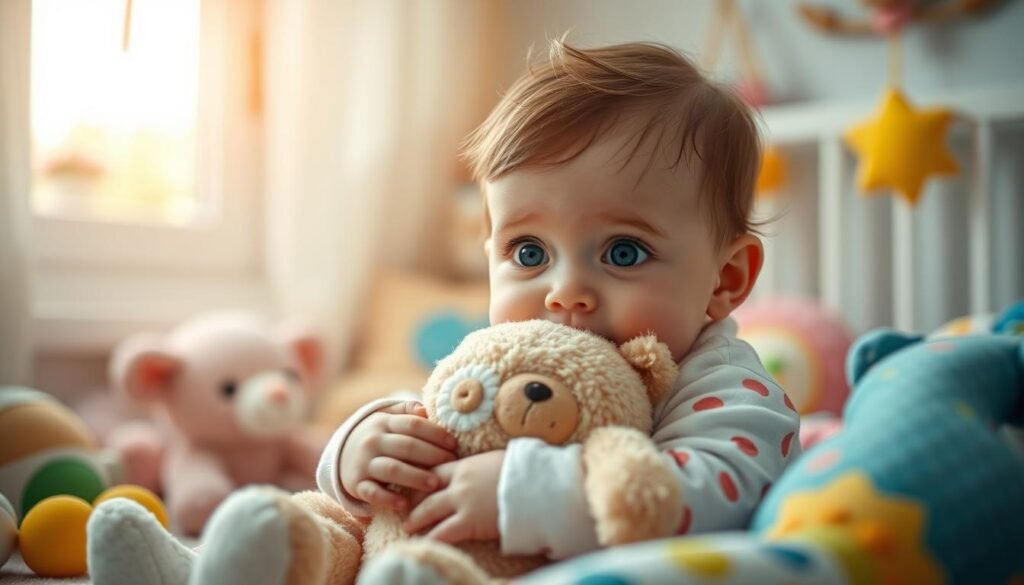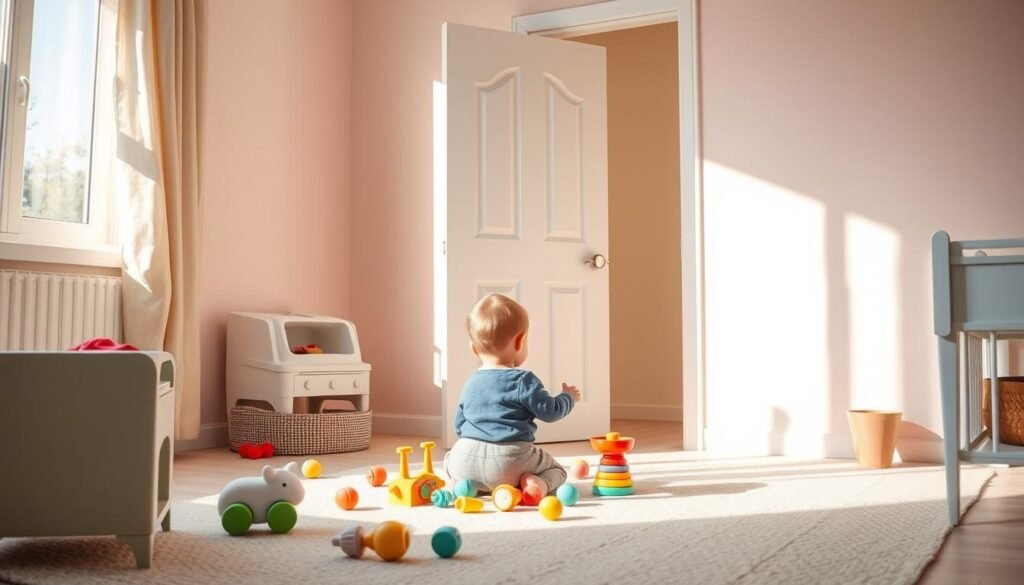Did you know babies often start to show separation anxiety at about 9 months old? This phase can make both kids and caregivers feel stressed. Infants begin to grow close emotional ties with their main caregivers. This can lead to them being clingy or having trouble sleeping.
It’s vital for parents to spot these signs early. This understanding can help manage the child’s anxiety and lessen feelings of guilt in parents. Expert tips can guide caregivers through this, making the journey smoother for everyone.
It’s key to grasp the details of baby separation anxiety to foster a secure bond. Practice short goodbyes and stick to a regular schedule to boost your child’s independence. Yet, let them know you’re always there. Look into the important signs and effective ways to address it. This can ease the journey for both kids and parents during this tough developmental period.
Key Takeaways
- Separation anxiety typically starts around 9 months but can begin as early as 4 or 5 months.
- It’s important to recognize common signs like crying and clinginess.
- Establishing a consistent routine can significantly ease separation for both the child and caregiver.
- Practicing gradual separations can help children develop independence.
- Happy reunion rituals can strengthen the parent-child bond and alleviate anxiety.
- Providing comfort items can soothe babies during times of separation.
Understanding Baby Separation Anxiety
Baby separation anxiety is when a child gets upset if their main caregiver isn’t around. This usually starts from six months to three years old, peaking at about nine to ten months. It’s part of how kids realize they need their caregivers a lot. When they learn their caregivers can’t always be by their side, they might feel anxious. This worry is a normal sign that the child and parent have a strong bond.
Early on, parents might see this anxiety mainly with family or those close to the child. The concept of object permanence—knowing people and things still exist even if they can’t be seen—often triggers the child’s unease during separations. Although it may cause concern, it’s crucial for the child to develop ways to cope. These skills will help them in their future relationships.
Taking short breaks from each other can help the child get used to being apart from their caregiver. However, if the anxiety stays for a long time and upsets the child’s daily life, talking to a health visitor may help. Supporting the child through these emotions is important. It encourages them to grow in a healthy way as they learn to manage their feelings.
Common Signs of Baby Separation Anxiety
It’s helpful to know the signs of baby separation anxiety for caregivers. Symptoms differ from child to child. Yet, some common signs are increased clinginess, lots of crying, a fear of strangers, and sleep issues.
Increased Clinginess and Crying
Babies become very clingy when they feel anxious. They stay close to their caregivers for comfort and safety. This often leads to a lot of crying if they’re separated. Parents should see this as a normal reaction to feeling unsure.
Fear of Strangers
Along with separation anxiety, many children fear unfamiliar people. This fear grows if a trusted caregiver isn’t around. The child might cry or pull away when strangers come close. This is a normal part of growing up. It shows a strong connection with their caregivers.
Sleep Disturbances
Separation anxiety can also disturb a baby’s sleep. They might cry at night, wanting their caregiver. Or, they may wake up often or struggle to sleep alone. A regular bedtime routine can calm these fears. It lets the child feel safe and understood.

When Does Baby Separation Anxiety Peak?
Parents can handle separation anxiety better by understanding its peak times. It usually matches major steps in a child’s growth. Knowing this helps caregivers give the right support when it’s tough.
Key Developmental Milestones
Separation anxiety starts when babies learn about object permanence. They realize when a caregiver leaves, they’re really gone. This often starts around 9 months. By 14 to 18 months, with more mobility and smarts, kids react more as they get how they fit with their caregivers.
Typical Age Ranges for Separation Anxiety
Babies and toddlers show separation anxiety at different times. Babies often show it from 8-10 months and then at 14-18 months. Toddlers might show it again around age 3. These times show how kids learn about relationships. By 4, these feelings usually get better, making separations easier.

| Age Range | Developmental Milestone | Signs of Separation Anxiety |
|---|---|---|
| 0 – 6 months | Initial attachment formation | Easily adjust to caregivers |
| 8 – 10 months | Understanding object permanence | Clinginess, crying during separation |
| 14 – 18 months | Increased mobility and social awareness | Tantrums, anxiety when parents leave |
| 2 – 3 years | Development of independence | Sleeplessness, nightmares about separation |
| 3+ years | Improved memory and environmental awareness | Reduced anxiety, increased exploration |
Causes of Baby Separation Anxiety
Baby separation anxiety is caused by many things. A big factor is the development of object permanence. This is when infants realize caregivers are still around, even if not seen. This understanding can make them anxious when away from those they are used to.
Understanding Object Permanence
Object permanence starts to show up in babies around six to eight months and changes how they see separation. It makes babies upset when not with familiar people. They seek to make sure their caregiver is still there, which can cause anxiety when they are not.
Attachment Issues and Emotional Bonds
Strong emotional bonds help babies grow healthily. They make it easier for babies to handle being apart from their caregivers. On the other hand, problems with attachment can make babies more anxious. They might not be sure their caregiver will come back. These bonds are key in how kids handle being apart.
Impact of Changes in Caregivers
Changing caregivers can shake a child’s feeling of safety. New caregivers, a sibling’s birth, or new childcare can upset their normal routines. These changes can make kids unsure about their caregiver’s return. Also, babies pick up on stress from their caregivers, increasing their anxiety when separate.

Expert Tips for Easing Baby Separation Anxiety
Separation anxiety is common in young kids, affecting infants to preschoolers. Caregivers can use strategies to ease this anxiety. These tips help create a sense of security.
Keeping a regular routine is key. It builds trust with children. Introducing brief times apart teaches babies care return after leaving. Games like peek-a-boo show them what separation and coming back look like.
Caregivers have several strategies to reduce anxiety. It’s best to keep goodbyes short but positive. Avoid sneaking away, as it can cause more worry. Seeing caregivers leave helps kids understand they’ll come back. Being punctual when returning builds their trust and confidence.
| Strategy | Description | Benefits |
|---|---|---|
| Consistent Routine | Establish daily habits for predictability. | Promotes stability and security. |
| Brief Separations | Practice short periods apart. | Helps babies understand that caregivers will return. |
| Playful Activities | Incorporate games like peek-a-boo. | Encourages healthy interaction with separation. |
| Positive Goodbyes | Keep farewells cheerful and brief. | Reduces anxiety associated with separation. |
| Visible Goodbyes | Always ensure children see caregivers before leaving. | Reinforces the concept of temporary separation. |
| Return on Time | Stick to promised return times after separations. | Builds trust and alleviates fears. |
Using these tips can help with separation anxiety. They aim to make the emotional environment more secure. This builds resilience in children during separations.
Practicing Brief Separations
Helping kids with separation anxiety means using smart steps, like short trial separations. This method helps babies slowly get used to being away from people they rely on, which makes them feel safer and stronger as they grow.
Importance of Gradual Exposure
Slowly getting used to being apart is key to overcoming separation anxiety. Starting with just a few minutes apart helps build a baby’s confidence. For example, leaving your child with someone they trust for a bit, then slowly lengthening that time, helps them feel secure.
These steps make sure kids know their caregivers will come back. This builds their emotional stability. It teaches them that being apart isn’t scary, setting them up for success in the future.
Engaging in Playful Separation Games
Games like peek-a-boo are great for teaching about being apart. Through these games, kids learn that even if they can’t see their caregivers, they will return. Other games, like hide and seek, also show that separations are just for a little while.
These fun activities help children see short times apart as enjoyable, not scary. Adding comforting routines during these games can also aid their emotional growth. It helps them adapt to new situations more easily.
Getting children used to short separations early on builds their emotional intelligence. These skills are important as they face different situations where they’ll be apart from loved ones. It supports their emotional well-being as they grow.
Creating a Consistent Routine
Establishing a regular routine is key for toddlers dealing with separation anxiety. Having set daily activities brings them comfort. It makes them feel stable. Knowing what comes next eases their stress during changes. This structure decreases their anxiety, making it easier to handle goodbyes.
Benefits of Stability and Predictability
Having a consistent routine gives kids a feeling of safety. It teaches them what to expect next, easing adaptation. This steadiness builds their independence and confidence. They can face new situations without too much fear. Regular times for eating, playing, and sleeping are part of this.
Integrating Goodbye Rituals
Goodbye rituals help ease separation anxiety. They provide a consistent way to say farewell. Kids learn to expect and accept these goodbyes as normal. Examples include a special handshake or a specific saying. These rituals boost their confidence and reassurance. For more tips on separation anxiety, visit this guide.
Supporting Independence during Separation
Helping a child be independent is key during times of separation anxiety. Teaching babies to be self-sufficient builds strong emotional health. They learn to feel safe on their own. Exploring on their own is exciting for kids. It shows them they can be adventurous without their caregivers around.
Fostering Autonomy in Baby
For independence, caregivers must provide safe ways for babies to learn about their world. Activities like playing with safe toys help babies make choices on their own. Supporting their independence also reassures them, making time apart easier for both.
Encouraging Safe Exploration
Safe exploration helps reduce the stress of separation anxiety. Introducing kids to new places, like parks, is a good start. Being there helps them feel brave to explore. Playdates help too, as they make friends in a safe setting. For tips on easing separation anxiety, visit this site.